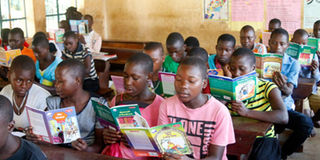Slow writing, reading in children linked to brain impairment

Pupils of Muguluka Primary School in Jinja District in a reading session in 2019. PHOTO | FILE
What you need to know:
- Dr Njuki, a specialist in speech and language therapy and a lecturer at Kyambogo University, said dyslexic children are highly gifted and talented but they face immense challenges in their written and oral expression because of a brain impairment
Educationists and therapists have linked the low ability of some children in writing and reading to dyslexia, a brain impairment estimated to affect one in five people in the population.
“Dyslexia is the most common learning challenge globally although it is the least understood condition,” said Dr Eria Paul Njuki, the director of Center for Life-Long Learning (CELL) in Wakiso, a school which educates persons with dyslexia.
Dr Njuki, a specialist in speech and language therapy and a lecturer at Kyambogo University, said dyslexic children are highly gifted and talented but they face immense challenges in their written and oral expression because of a brain impairment.
“The biggest barrier for these children is examination; these children are so good when it comes to participating in class orally but when it comes to writing down, they fail in examination. There is a problem when it comes to their written and oral expression,” he said in an interview on Friday.
“It (dyslexia) affects 1 in 5 people, according to the National Institute of Health in the United States. In Uganda, we don’t have data of our own, so we just approximate,” Dr Njuki added.
Ms Sarah Bugoosi Kibooli, the commissioner for special needs and inclusive education at the Education ministry, said there is a need to train teachers on how to handle children with dyslexia and those with other disabilities.
“Many of us have children at home and even in school who cannot read and write and yet they are very brilliant. When you teach them, they are able to give you all answers right but they are not able to write them,” the commissioner said in an interview.
“And because they cannot write, when they are given exams, they get zero or less than 10 percent and then we call them non-performers and yet they only have a disability that has not been identified and there is no intervention then,” she added.
Ms Seerah Dianah Leah, the programme officer for Inclusive Education at the National Union of Disabled Persons of Uganda (NUDIPU), on the other hand, said there is a need for educators to understand dyslexia so learners are accorded the support they need to excel.
“Dyslexia is a learning difficulty which affects reading and writing. Most learners with this condition are never diagnosed hence end up going through education without getting the required support. They end up as average learners and sometimes ungraded learners,” she said.
According to the Uganda Bureau of Statistics of 2016, about 12 percent of the population has some form of disability, and the literacy rate for those aged 10 years and above was at 73 percent then.
Dr Njuki said through their negotiations with the government, something is already being done for dyslexic learners.
“From 2016, the Uganda National Examination Board, has allocated more time for candidates with dyslexia. They are given more 45 minutes when these children are reported early but unfortunately, most schools don’t screen for dyslexia, so they think these children are lazy. There is a provision in the registration form to indicate that the student has dyslexia,” he said.
Ms Bugoosi said to effectively support all learners with such impairment and other disabilities, they have been pushing for the national inclusive education policy that would aid their work.
“In this policy, we expect you to see the kinds of disabilities that exist. Also, to bring on board any other intervention that we find fit,” she said.
Adding: “Right now the policy is at cabinet level. We are still working on it and we know that in the shortest time possible, it will be out. ”
Trend
A 2021 report by Uwezo indicated that although school enrollment has increased to 8.5 million people, only 39.5 percent of children from Primary Three to Primary Seven had the required competence in reading.




